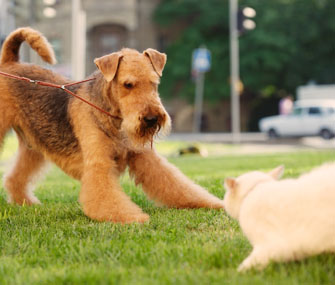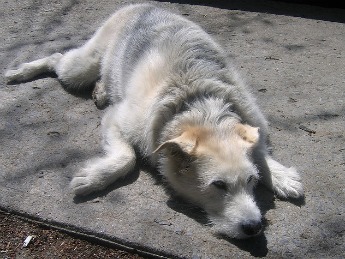Although there are countless households with dogs and cats who can live in harmony, mixing the two species can sometimes cause discord and stress for everyone in the home — people included.
Many cats lack positive experiences with dogs and will automatically flee when a canine comes near them. Dogs, in turn, want to chase after cats who run away because they resemble prey. And although most dogs will stop the predatory sequence as soon as they reach the cat and will not attack, there are certain canines with high predatory aggression who can seriously injure or kill a feline.
In households with more than one dog, the chase can turn even more intense if several dogs are running after a cat, a situation that only heightens each canine’s excitement level. Even if there is no physical contact, the emotional stress on a cat who is living in constant fear can lower the feline’s quality of life.
When to Separate the Warring Factions
If there is a canine in your home with true predatory aggression, who has the ability to inflict bodily harm on your cat, you need to either separate the dog and cat completely from each other in different parts of the house or look at other solutions, such as re-homing one of your companions. Although this is far from the perfect solution, when the safety and emotional well-being of a cat is at risk, re-homing may be the kindest solution.
Create a Comfort Zone for Your Cat
Your feline’s stress level can be drastically reduced if you provide your kitty with a separate living area, such as a room with a high enough baby gate that keeps the dogs out but that the cat can jump over. Many cats will also relax if they have easy access to elevated areas, such as cat perches. Lastly, your cat should only be in the presence of the dogs when you are around to supervise their interactions.
Train Your Dogs First
You should designate one person in the home to train each dog. Start with one dog and desensitize him to your cat’s presence slowly by having him on a leash or in a head halter to limit access to the feline. Place the cat on the other side of a baby gate or inside a carrier, then stand with the canine at a good distance from the cat — about the length of a large room — and ask your pooch for a known command, such as sit. When your dog stays in the position, reward him with a treat. The ultimate goal is to teach him a different way of responding to the cat.
When you sense that your dog relaxes in the cat’s presence, as well as connects that the cat is linked to rewards or ignores the feline altogether, you can gradually add new variables to the training scenario. This can include bringing the carrier closer to the dog or letting the cat out from behind the baby gate.
If your dog tries to lunge for the cat, the leash or head halter will allow you to safely remove him for a training break before you repeat the process at a lower level of intensity. You should never punish your canine for reacting to the cat, because this only increases his arousal level.
Train Your Cat and Dogs Together
Once both dogs have shown that they can relax and show control around your cat, they can be trained together, starting with the cat on the other side of the room. Leashes or head harnesses can be slowly phased out once your dogs have proven that they will not chase after your cat. Start by letting their leads drag on the ground first before removing them completely, so you can still restrain your dogs if necessary.
Remember to always keep your cat’s safety in mind: Even with successful training, you should separate your dogs from the cat when you are not around to supervise.
~ Written by Mikkel Becker





